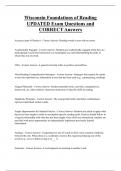Wisconsin Foundations of Reading
UPDATED Exam Questions and
CORRECT Answers
Accuracy (part of fluency) - Correct Answer- Reading words in text with no errors.
Academically Engaged - Correct Answer- Students are academically engaged when they are
participating in activities/instruction in a meaningful way and understanding the tasks in
which they are involved.
Affix - Correct Answer- A general term that refers to prefixes and suffixes.
After-Reading Comprehension Strategies - Correct Answer- Strategies that require the reader
to actively transform key information in text that has been read (e.g., summarizing, retelling)
Aligned Materials - Correct Answer- Student materials (texts, activities, manipulatives,
homework, etc.) that reinforce classroom instruction of specific skills in reading.
Alphabetic Principle - Correct Answer- The concept that letters and letter combinations
represent individual written words.
Ample Opportunities for Student Practice - Correct Answer- Students are asked to apply what
they have been taught in order to accomplish specific reading tasks. Practice should follow in
a logical relationship with what has just been taught. Once skills are internalized, students are
provided with more opportunities to independently implement previously learned
information.
Analogy - Correct Answer- Comparing two sets of words to show some common similarity
between the sets. When done as a vocabulary exercise this requires producing one of the
words (e.g., cat is to kitten as dog is to___?)
Antonym - Correct Answer- A word opposite in meaning to another word.
,Automaticity - Correct Answer- Reading without conscious effort or attention to decoding.
Background Knowledge - Correct Answer- The knowledge and understandings of the world
that students have acquired through their everyday experiences--riding in cars or buses,
playing and talking with other children and adults, that help them to make sense of the texts
they read.
Base Word - Correct Answer- A unit of meaning that can stand alone as a whole word (e.g.,
friend, pig). Also called a free morpheme.
Before-Reading Comprehension Strategies - Correct Answer- Strategies employed to
emphasize the importance of preparing students to read text (e.g., activate prior knowledge,
set a purpose for reading).
Blending - Correct Answer- The task of combining sounds rapidly, to accurately represent the
word.
Bloom's Taxonomy - Correct Answer- A system for categorizing levels of abstraction of
questions that commonly occur in educational settings. Includes the following competencies:
Knowledge, comprehension, application, analysis, synthesis, and evaluation.
ChoralReading/Chanting - Correct Answer- Two or more individuals reading aloud from the
same text-this can help students to develop oral reading fluency.
Chunked Text - Correct Answer- Continuous text that has been separated into meaningful
phrases often with the use of single and double slash marks (/ and //). The intent of using
chunked text or chunking text is to give children an opportunity to practice reading phrases
fluently.
Chunking - Correct Answer- A decoding strategy for breaking words into manageable parts
(e.g., yes/ter/day). Chunking also refers to the process of dividing a sentence into smaller
phrases where pauses might occur naturally (e.g., When the sun appeared after the storm, /
the newly fallen snow. shimmered like diamonds).
Comprehension - Correct Answer- Understanding what one is reading, the ultimate goal of all
reading activity.
, Comprehension Questions - Correct Answer- Questions that address the meaning of text,
ranging from literal to inferential to analytical.
Concepts About Print/Conventions of Print - Correct Answer- The understanding an
individual has about the rules or accepted practices that govern the use of print and the use of
written language. For example concepts about print include: reading left to right, top to
bottom, words are made of letters, use of spaces between words, use of upper case letters,
spelling patterns, punctuation, etc.
Concept Definition Mapping - Correct Answer- Provides a visual framework for organizing
conceptual information in the process of defining a word or concept. The framework contains
the category, properties, and example of the word or concept.
Connected Text - Correct Answer- Words that are linked (as opposed to words in a list) as in
sentences, phrases, and paragraphs.
Consonant Blend - Correct Answer- Two or more consecutive consonants which retain their
individual sounds (e.g., bl in block; str in string)
Consonant Digraph - Correct Answer- Two consecutive consonants that represent one
phoneme, or sound (e.g., ch, sh).
Context/Context Cues - Correct Answer- Information from the surrounding texts that helps
identify or gives meaning to a sepcific word or phrase i.e. "yesterday I read the book". The
words surrounding "read" help us know how to pronounce it.
Context Clue - Correct Answer- Using words or sentences around an unfamiliar word to help
clarify its meaning.
Conventional Spelling - Correct Answer- Spelling that is in the standard or correct form for
written documents.
Cueing System - Correct Answer- Any of the various sources of information that may aid
identification of a word such as: graphophonics, semantic and syntactic informaiton.




